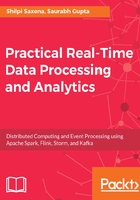
Edge analytics
Post evolution and IOT revolution, edge analytics are another significant game changer. If you look at IOT applications, the data from the sensors and devices needs to be collated and travels all the way to the distributed processing unit, which is either on the premises or on the cloud. This lift and shift of data leads to significant network utilization; it makes the overall solution latent to transmission delays.
These considerations led to the development of a new kind of solution and in turn a new arena of IOT computations — the term is edge analytics and, as the name suggests, it's all about pushing the processing to the edge, so that the data is processed at its source.
The following figure shows the bifurcation of IOT into:
- Edge analytics
- Core analytics

As depicted in the previous figure, the IOT computation is now divided into segments, as follows:
- Sensor–level edge analytics: Wherein data is processed and some insights are derived at the device level itself
- Edge analytics: These are the analytics wherein the data is processed and insights are derived at the gateway level
- Core analytics: This flavour of analytics requires all data to arrive at a common compute engine (distributed storage and distributed computation) and then the high–complexity processing is done to derive actionable insights for people and processes
Some of the typical use cases for sensor/edge analytics are:
- Industrial IOT (IIOT): The sensors are embedded in various pieces of equipment, machinery, and sometimes even shop floors. The sensors generate data and the devices have the innate capability to process the data and generate alerts/recommendations to improve the performance or yield.
- IoT in health care: Smart devices can participate in edge processing and can contribute to detection of early warning signs and raise alerts for appropriate medical situations
- In the world of wearable devices, edge processing can make tracking and safety very easy
Today, If I look around, my world is surrounded by connected devices—like my smart AC, my smart refrigerator, and smart TV; they all send out the data to a central hub or my mobile phone and are easily controllable from there. Now, the things are actually getting smart; they are evolving from being connected, to being smart enough to compute, process, and predict. For instance, my coffee maker is smart enough to be connected to my car traffic, my office timing, so that it predicts my daily routine and my arrival time and has hot fresh coffee ready the moment I need it.